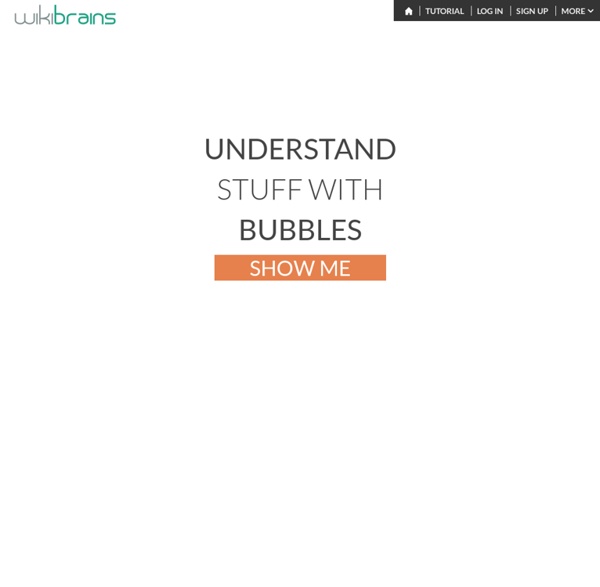



Ten Terrific Mind Mapping and Brainstorming Tools Today, I am running a workshop about using mind mapping and brainstorming tools to help students meet some of the Common Core standards in English Language Arts. Below are some of the tools that we will be using today. On a related note, if you're interested in having me come to your school or facilitate a virtual workshop, please click here for more information. Popplet is a great service that combines the best of online sticky note services like Wallwisher with collaborative mind mapping functions. Popplet allows you to create a wall of multimedia sticky notes that you can share with others.
Mind Mapping Uses in Education This guest post was written by Richard – a mind mapping specialist at MindMeister – a leading provider of mind mapping solutions. Mind mapping is fast becoming a must have tool in education, increasing in popularity with both students and teachers alike. Many school districts and universities across Europe, Canada and the US have turned to mind mapping software as their cloud based solution for file sharing, online collaboration and brainstorming. Safe search engines for kids? Reader Q+A at Cool Mom Tech What’s the best search engine for kids, in your experience? -via Twitter Keeping kids safe online should be a huge priority for parents.
Dustin Bachrach Blog Flickpad 2: Every Photo. Every friend. Every day. How To Make Students Better Online Researchers I recently came across an article in Wired Magazine called “ Why Kids Can’t Search “. I’m always interested in this particular topic, because it’s something I struggle with in my middle and high school classes constantly, and I know I’m not alone in my frustrations. Getting kids to really focus on what exactly they are searching for, and then be able to further distill idea into a few key specific search terms is a skill that we must teach students, and we have to do it over and over again. We never question the vital importance of teaching literacy, but we have to be mindful that there are many kinds of “literacies”. An ever more important one that ALL teachers need to be aware of is digital literacy. I could go off in many directions on this, but for the purpose of this post I’m focusing strictly on the digital literacy of searching.
iMindMap - Basic People within organisations and educational institutions around the world are already seeing the benefits of iMindMap – start discovering them yourself today. “Your Mind Mapping software has transformed our business & become a part of our cultural DNA.” Wheaton Wealth Partners, USA 12 Things Students Should Never Do on Social Media The last thing young people want is another set of rules. But these days, social media comes with great responsibility, whether you're just starting high school or finishing up college. The fact is, irresponsible social media conduct could potentially ruin your education and negatively impact your career, not to mention hurt others in the process. (And we're not just talking kids, either.) But most of those consequences are preventable, often with just a little foresight. We've pinpointed 12 social media mistakes that students should avoid at all costs, because after all, it's never as simple as "be responsible."
Five-Minute Film Festival: Teaching Digital Citizenship "Digital citizenship" is an umbrella term that covers a whole host of important issues. Broadly, it's the guidelines for responsible, appropriate behavior when one is using technology. But specifically, it can cover anything from "netiquette" to cyberbullying; technology access and the digital divide; online safety and privacy; copyright, plagiarism, and digital law, and more. Wisemapping A mind map is a diagram used to represent words, ideas, tasks, or other items linked to and arranged around a central key word or idea. Especially in British English, the terms spidergram and spidergraph are more common,[1] but they can cause confusion with the term spider diagram used in mathematics and logic. Mind maps are used to generate, visualize, structure, and classify ideas, and as an aid to studying and organizing information, solving problems, making decisions, and writing. The elements of a given mind map are arranged intuitively according to the importance of the concepts, and are classified into groupings, branches, or areas, with the goal of representing semantic or other connections between portions of information.
Top 10 Ed-Tech Startups of 2012 It probably goes without saying, but I’ll type it out anyway: 2012 was an incredible year for education technology startups. Launches. Updates. Funding. Acquisitions. Adoption. How To Get Rid Of Facebook Notifications & Other Annoying Things You Don’t Want To See [Weekly Facebook Tips] It’s funny how sometimes you can use an online service all the time, getting annoyed at little things without realising there’s an easy way to do something about it. Several of my friends who use Facebook almost every day recently told me how they hate always getting Facebook notifications for dumb games people want them to play, or updates about these games in their home feed. Obviously, if these people can be avid Facebook users without knowing there’s a fix, then there’s bound to be a few more of you out there too.
How to Make Forms, Surveys, and Quizzes in Google Docs and Spreadsheets or Google Apps Want to find out what your coworkers want for lunch? Need to get feedback for your training session? Want to find out which movie your friends want to see on Saturday? Do you need a database of your club member's phone numbers? Information Literacy - Home What is Information Literacy? Information Literacy is the ability to identify what information is needed, understand how the information is organized, identify the best sources of information for a given need, locate those sources, evaluate the sources critically, and share that information. It is the knowledge of commonly used research techniques.